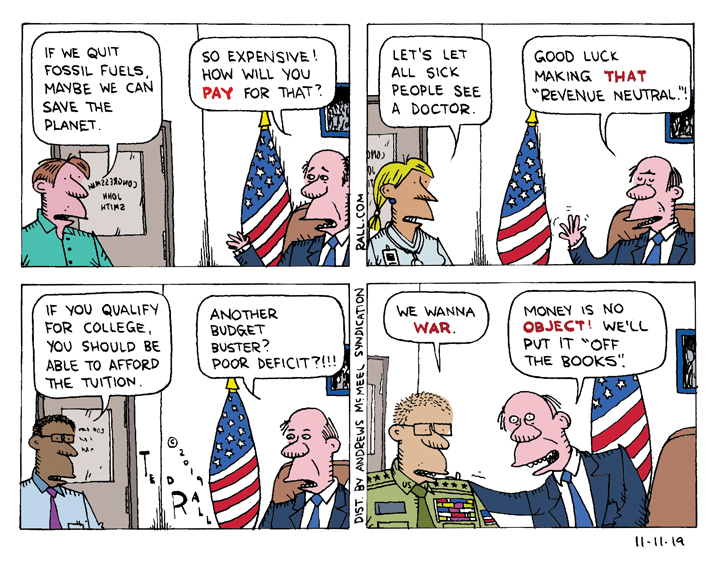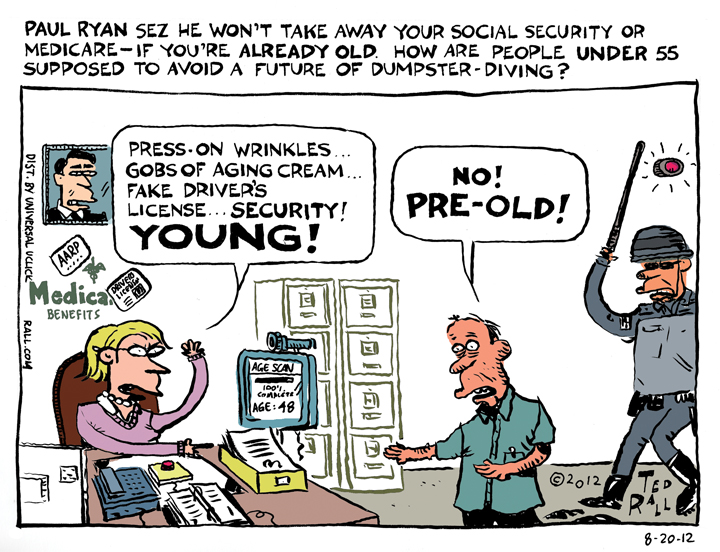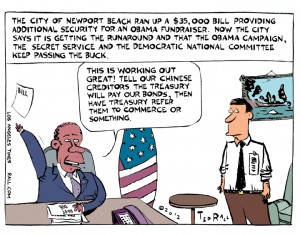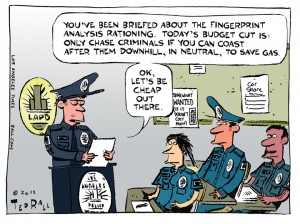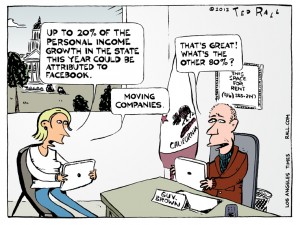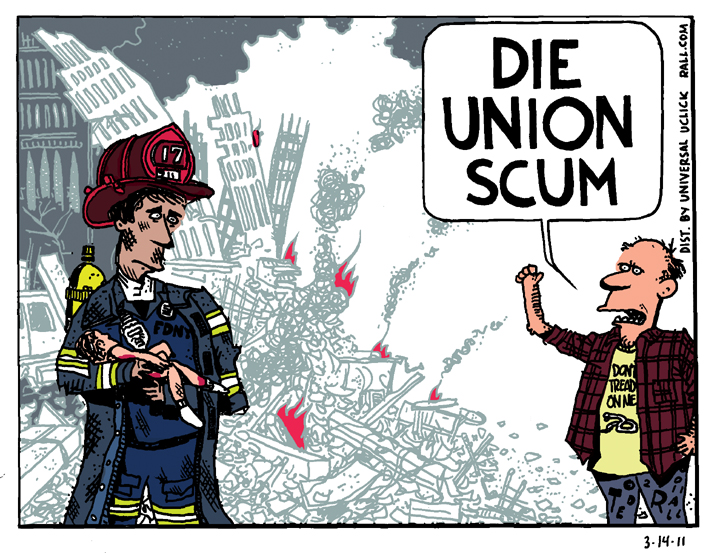Whenever someone wants to start a war, nobody ever asks how we are going to pay for it. But when there is a proposal to help people with basic human needs, suddenly the budget becomes a top consideration.
SYNDICATED COLUMN: Big Bird is a 1%er
Romney’s Silly But Salient Point on PBS
“I like PBS. I love Big Bird. Actually, I like you, too,” Mitt Romney told Jim Lehrer in the most quoted line from the first presidential debate. “But I’m not going to keep on spending money on things to borrow money from China to pay for.”
Huge news!
If deficit spending will be verboten under the Mittocracy, what will happen to all those out-of-work soldiers and defense contractors? Where will the drones crash after they run out of gas?
But let’s not talk about that either. Apparently I’m the only person in America who noticed that the military-industrial complex is about to go out of business.
People are instead focusing on Romney’s call to cut the $445 million a year the federal government–which amounts to a paltry 1.2% of 1% of the federal budget–contributes to the Corporation for Public Broadcasting, which subsidizes PBS and NPR.
My fellow political cartoonists are having a field day, echoing President Obama’s hat tip to the O.J. case: “Elmo has been seen in a white Suburban. He’s driving for the border.” The New York Times’ Charles M. Blow riffed: “Big Bird is the man. He’s eight feet tall. He can sing and roller skate and ride a unicycle and dance. Can you do that, Mr. Romney?” A co-creator of “Sesame Street” dismissed Romney as “silly.”
Silly? Definitely.
But is Romney right? Probably.
Candidates and parties aren’t important. Ideas are. If we’re ideologically consistent, if we want to appear credible when we criticize right-wingers like Romney, we left-of-center types have to hold ourselves to the same (or higher) standards as those to which we subject our enemies. We have to admit when they’re correct, even–especially–when it’s about something as trivial as this.
This is a time when we have to give the devil his due.
Until recently I was unaware of the exorbitant salaries received by executives and top employees of federally-subsidized broadcasting networks. In a 2011 op-ed for The Wall Street Journal, Senator Jim DeMint (R-SC) pointed out that PBS paid its president, Paula Kerger, over $600,000 a year–more than the President of the United States. “Kevin Klose, president emeritus of NPR…received more than $1.2 million in compensation, according to the tax forms the nonprofit filed in 2009,” wrote DeMint. “Sesame Workshop President and CEO Gary Knell received $956,513 in compensation in 2008.” (Now Knell runs NPR, which pays him about $575,000.)
Actor Carroll Spinney, who plays Big Bird and Oscar the Grouch, was paid more than $314,000 last year.
The liberal Center for American Progress countered: “While those numbers are not exactly chump change, it’s pennies compared to the salaries of another industry the U.S. taxpayers subsidize at much higher cost–Big Oil.”
But that’s red-herring sophistry.
Wasteful federal spending on overpaid executives is wrong, whether it’s for planet-murdering energy corporations, or on a network that airs free educational TV that helps ready kids for school with basics like counting, math and even Spanish.
Kill both.
“Like for-profit media companies, Sesame [and PBS] needs to pay top dollar to attract talent,” MSN’s Jonathan Berr argues, sounding like a Fortune 500 corporation defending sky-high CEO paychecks.
I disagree.
NPR and PBS do an OK job reporting the news–as long as it happens on a weekday–but that’s not the point.
If you accept public money, you’re in public service and should get paid accordingly. Which is to say, fairly–and at the lowest fair cost to taxpayers.
If you can’t find someone qualified to run NPR or PBS, or an actor up to the task of playing Big Bird, for $100,000 a year–especially in this job market–you’re not looking hard enough. Something is off-kilter when the studios of publicly-funded shows like NPR’s “All Things Considered” are centrally located and sumptuously furnished with mahogany tables and the latest high-tech gadgetry, while those of privately-owned 50,000-watt talk-radio powerhouses are situated in the slums and look like 1970s-era flophouses.
Salary figures for NPR “stars” like Robert Siegel ($341,992), Renee Montagne ($328,309), Steve Inskeep ($320,950), Scott Simon ($311,958) and Michele Norris ($279,909) are three to four times more than top-rated talk-radio hosts in the biggest markets get. How dare these 1%ers shake us down during pledge drives, much less collect federal taxdollars?
PBS only receives 15% of its funding from the feds. For NPR it’s 2%. As a former NPR exec confided, given the political heat they take over it, they’d might be better off cutting the strings. Then they’d be free to stop giving lying conservatives “equal time” to seem “fair.”
Why is the government giving broadcasters money they don’t need? There’s a much stronger argument for propping up newspapers, which remain the original source of 95% of news stories. Print media is in big trouble: the newspaper industry has shrunk 43% since 2000. Analysts say that even that chart-filled ubiquitous denizen of hotels USA Today may fold. If the feds want to do something good for journalism–and the well-informed populace required for vibrant democracy–they should start by subsidizing print newspapers.
But only if their editors and publishers don’t get paid ridiculous salaries.
(Ted Rall‘s new book is “The Book of Obama: How We Went From Hope and Change to the Age of Revolt.” His website is tedrall.com. This column originally appeared at MSNBC’s Lean Forward blog.)
COPYRIGHT 2012 TED RALL
LOS ANGELES TIMES CARTOON: A California Town Gets The Runaround
I draw cartoons for The Los Angeles Times about issues related to California and the Southland (metro Los Angeles).
I draw cartoons for The Los Angeles Times about issues related to California and the Southland (metro Los Angeles).
This week: The city of Newport Beach ran up a $35,000 bill providing additional security for an Obama fundraiser. Now the city says it is getting the runaround and that the Obama campaign, the U.S. Secret Service, and the Democratic National Committee keep passing the buck.
Los Angeles Times Cartoon: The Other 80%
I draw cartoons for The Los Angeles Times about issues related to California and the Southland (metro Los Angeles).
This week: Up to 20% of the personal income growth in the state of California could be attributed to the initial public offering of stock by Facebook. So what’s the other 80%?
SYNDICATED COLUMN: Yes, I Can
Straight Talk on Balancing the Budget
The federal budget deficit is like the weather. Everybody talks about it; except for Bill Clinton, no one ever does anything about it.
President Obama’s bipartisan Fiscal Debt Commission has released a draft report that starts out with a big problem: even talking about reducing spending is insane when you’re in the midst of a Depression. The real unemployment is over 20 percent. Creating jobs ought to be the feds’ top—perhaps sole—priority.
Let the insanity commence.
Triumphant Republicans say they want to balance the budget. So does Obama. Are they serious? Of course not.
Still, theoretical budget-balancing exercises help enlighten us about where our taxdollars really go. So let’s roll up our sleeves and start some back-of-the-envelope slashing.
The 2010 federal budget shows $3.6 trillion in spending and $2.4 trillion in revenues. Net deficit: $1.2 trillion. It’s a doozy, too. It nearly 13 percent of GDP. It’s the highest since 1943, during World War II.
The goal, then, is to close a $1.2 trillion budget gap. Can we find at least $1.2 trillion in budget cuts? News flash: getting rid of the National Endowment for the Arts ($161 million in 2010, or about 0.01 percent of the deficit), ain’t gonna do the trick.
Any serious budget cutter has to start with defense. The reason is simple: it accounts for 54 percent of discretionary (i.e., optional) federal spending. It’s the biggest piece of the pie by far.
(Mainstream news reports usually state that defense accounts for 20 percent of federal outlays. But they’re fudging the facts in order to pretty up the military-industrial complex. For example, they include budget items like Social Security that no one can do anything about—they’re in a trust fund.)
Of that 54 percent, 18 percent is debt service on old wars. There’s nothing we can do about that—though that number should probably give us pause the next time a president wants to invade Panama or Grenada.
Anyway, that leaves 36 percent, or $1.3 trillion to play with. $200 billion a year goes to Afghanistan and Iraq.
Let’s pull out. We’re losing anyway.
New Deficit: $1.0 trillion.
In 2007 Chalmers Johnson wrote a book about the staggering costs of American imperialism. “The worldwide total of U.S. military personnel in 2005, including those based domestically, was 1,840,062 supported by an additional 473,306 Defense Department civil service employees and 203,328 local hires,” he wrote. “Its overseas bases, according to the Pentagon, contained 32,327 barracks, hangars, hospitals, and other buildings, which it owns, and 16,527 more that it leased. The size of these holdings was recorded in the inventory as covering 687,347 acres overseas and 29,819,492 acres worldwide, making the Pentagon easily one of the world’s largest landlords.”
We’re broke. It’s time to bring those 2.3 million men and women home. At an average cost of $140,000 per employee—crazy but true—we could save $322 billion annually.
New Deficit: $676 billion.
After Defense, the other big costs are Social Security, Medicare and Medicaid.
The obvious place to start slashing is wealthy recipients. Why should Bill Gates, worth $58 billion, get Social Security or Medicare benefits? Dean Baker sums up the traditional liberal argument in favor of giving tax money to people who don’t need it: “Social Security enjoys enormous bipartisan support because all workers pay into it and expect to benefit from it in retirement. Taking away the benefits that better-off workers earned would undoubtedly undermine their support for the program. This could set up a situation in which the program could be more easily attacked in the future.”
Yeah, well, whatever. We. Are. Broke. “Means testing”—for example, eliminating benefits for the approximately one percent of families over age 65 who earn over $100,000 a year—could save $150 billion a year.
New deficit: $526 billion.
Now let’s talk about the other side of the equation: income. How can the U.S. government scare up some extra cash?
Allowing the Bush tax cuts for the richest three percent of Americans to expire on schedule would bring in $70 billion a year. Seems like a no-brainer: anyone earning over $250,000 a year is doing awesome. Moreover, if Democrats don’t insist on the expiration of at least some of those “temporary” tax cuts, what’s the point of the deal they cut with the GOP back in 2001?
New deficit: $456 billion.
When it comes to revenues, you have to go where the money is: the wealthy. The rich have gotten richer, which is a big part of the reason we’re in a Depression again. They’re hogging all the goodies. The rest of us can’t spend.
Despite the miserable economy, there are still 2 million American households earning a whopping $250,000 or more per year. (Their average income is $435,000.) If we were to increase these super-rich Americans’ marginal income tax rate from 35 to 50 percent—the same it was during the early 1980s under Reagan—we’d bring in an extra $131 billion a year. If we raised it back to 91 percent—the top rate during the boom years between 1950 to 1963—the Treasury would collect $487 billion.
Budget SURPLUS: $31 billion.
And we haven’t started on corporate taxes.
(Ted Rall is the author of “The Anti-American Manifesto.” His website is tedrall.com.)
COPYRIGHT 2010 TED RALL

